(Press-News.org) Embargoed for release until 5:00 p.m. ET on Monday 30 September 2024
@Annalsofim
Below please find summaries of new articles that will be published in the next issue of Annals of Internal Medicine. The summaries are not intended to substitute for the full articles as a source of information. This information is under strict embargo and by taking it into possession, media representatives are committing to the terms of the embargo not only on their own behalf, but also on behalf of the organization they represent.
----------------------------
1. Time-restricted eating associated with greater blood sugar control and fat loss than standard nutrition counseling
Abstract: https://www.acpjournals.org/doi/10.7326/M24-0859
Summary for Patients: https://www.acpjournals.org/doi/10.7326/P24-0006
URL goes live when the embargo lifts
A randomized control trial of adults with metabolic syndrome evaluated the effect of time-restricted eating (TRE) on glucose control, fat mass, and weight loss. The data revealed that TRE led to greater modest improvement in glucose control and decreases in weight and fat mass when coupled with standard nutritional counseling than standard nutritional counseling alone. The study is published in Annals of Internal Medicine.
Researchers from the The Salk Institute and UCSD Medicine studied data from 108 adult participants with metabolic syndrome (MetS), elevated BMI, and elevated HbA1c or fasting glucose characteristic of prediabetes. They aimed to assess the efficacy of personalized TRE in participants on top of standard nutritional counseling to determine the effects of TRE as a lifestyle intervention. Researchers randomly assigned participants into two groups that had different interventions; in the first group, participants were given standardized lifestyle and nutritional recommendations and advised to continue their eating patterns. The second group was given the same nutritional recommendations, but they were also assigned to a personalized 8 to 10 hour eating window. Researchers remotely monitored the intervention for three months, during which the participants logged the timing of dietary intake in the myCircadianClock (mCC) app every day. The primary outcome was changes in fasting glucose, while secondary outcomes included changes in HbA1c and cardiometabolic parameters. Results found that, compared to the group receiving standard nutritional guidance, the TRE group not only had a greater decrease of weight, but a higher proportion of the weight lost was from fat—suggesting TRE likely poses a lower risk for deterioration of muscle associated with weight loss. Further, while the changes were modest, the TRE group observed greater improvement in blood sugar control and hemoglobin A1c levels. Ultimately, the data indicates that TRE is an effective practical lifestyle intervention with benefits for glycemic regulation and cardiometabolic health. The study contributes to the library of existing research on TRE and metabolic syndromes. In addition, its methodological innovation in using the mCC app enables future studies to be remote and at a larger scale.
Media contacts: For an embargoed PDF, please contact Angela Collom at acollom@acponline.org. To speak with corresponding author Satchidananda Panda, PhD, please email panda@salk.edu. To speak with corresponding author Pam R. Taub, MD, please email ptaub@ucsd.edu.
----------------------------
2. NIH Panel concludes COVID-19 guidelines, provides final treatment recommendations
Final guidelines provide insight into lessons learned for developing clinical guidelines in future emergency situations
Abstract: https://www.acpjournals.org/doi/10.7326/ANNALS-24-00464
URL goes live when the embargo lifts
The National Institutes of Health (NIH) COVID-19 Treatment Guidelines Panel released its final set of recommendations on February 29, 2024. This article includes a copy of the final guidelines and incorporates perspectives and lessons learned as the public health emergency ended. Convened in March 2020 at the request of the U.S. Department of Health and Human Services, the expert panel developed "living" guidelines, that were continuously updated as new data emerged and designed to be accessible to clinicians. Over the past four years, the panel provided treatment strategies for COVID-19 using FDA-approved and -authorized antiviral therapies and immunomodulators. Further recommendations will now transition to professional societies. The details are published in Annals of Internal Medicine.
According to the Panel, the final guidelines benefitted from the availability of 4 FDA-approved drugs for the treatment of COVID-19 as well as numerous well-conducted clinical trials that demonstrated the value of antiviral drugs, immunomodulators and other interventions and the lack of benefit of several other purported therapies that were promoted. The Panel’s treatment recommendations were organized by disease severity and were divided into nonhospitalized and hospitalized patient categories. For nonhospitalized patients the guidelines recommend early symptom management and antiviral use, especially in patients at high risk for progression to severe disease. For hospitalized patients, treatment to prevent further disease progression focuses on early intervention with remdesivir and treatment with dexamethasone, if needed. The Panel also recommended controlling inflammation and preventing blood clots with blood thinners in those not at increased risk for bleeding.
Included in this article is a summary of lessons learned during the pandemic. These lessons informed the guidelines, which were developed in full transparency to ensure credibility and objectivity. According to the Panel, these guidelines and the processes used to develop them should give professional societies a template they can follow when managing public health emergencies or pandemics in the future.
Media contacts: For an embargoed PDF, please contact Angela Collom at acollom@acponline.org. To speak with an author from the NIH, please email Kathy Donbeck at NIH kathy.donbeck@nih.gov or Krystle Lopez at Weill Cornell Medicine krl2003@med.cornell.edu.
----------------------------
3. For anemic patients suffering heart attacks, lower hemoglobin thresholds for transfusion may increase risk of death or recurrent heart attack
Abstract: https://www.acpjournals.org/doi/10.7326/M24-0571
Editorial: https://www.acpjournals.org/doi/10.7326/M24-0895
URL goes live when the embargo lifts
A prespecified secondary analysis of the MINT (Myocardial Ischemia and Transfusion) trial estimated the effect of 4 strategies to inform an optimal hemoglobin threshold for transfusion among anemic patients suffering from myocardial infarction (MI). The data revealed that 30-day risks for death or recurrent MI among patients seem to increase progressively with lower hemoglobin concentration thresholds for transfusion. The study is published in Annals of Internal Medicine.
Researchers funded by the National Heart, Lung, and Blood Institute studied data from 3,492 MINT trial participants with acute MI and anemia at 144 clinical sites in 6 countries. Participants were selected if they were 18 years or older, had type 1, 2, 4b, or 4c MI, and had a hemoglobin concentration below 10 g/dL. Researchers used target trial emulation methods to assess 4 transfusion strategies with hemoglobin thresholds of <10 g/dL, <9 g/dL, <8 g/dL, or <7 g/dL to trigger red blood cell (RBC) transfusion. The primary outcome of the study was a composite of all-cause death or recurrent MI, while a secondary outcome was all-cause death. Participants were followed until death, loss to follow-up or withdrawal, or day 30, whichever occurred first. The study design was innovative, with researchers synthesizing data from the MINT trial to conduct this secondary analysis that complemented the results of the former trial. The data suggested that risk for 30-day death or MI was higher for hemoglobin transfusion thresholds of less than 8 g/dL and less than 7 g/dL but did not differ for a threshold of less than 9 g/dL, each relative to a less than 10 g/dL threshold, indicating a possible relationship between low hemoglobin concentration thresholds for transfusion and an elevated 30-day risk for death or MI. The lower the threshold, seemingly the higher the risk. The results from this study inform the optimal transfusion threshold for this patient population and may help to guide clinical practice in patients with acute MI. These findings suggest that transfusion guidelines could consider avoiding hemoglobin triggers of less than 8 g/dL and less than 7 g/dL in patients with acute MI to minimize risk for hazardous outcomes.
Media contacts: For an embargoed PDF, please contact Angela Collom at acollom@acponline.org. To speak with corresponding author Maria M. Brooks, PhD, please e-mail mbrooks@pitt.edu.
----------------------------
4. Population-based suicide care program yields 25% reduction in suicide attempts
Abstract: https://www.acpjournals.org/doi/10.7326/M24-0024
URL goes live when the embargo lifts
A stepped-wedge, cluster randomized implementation trial found that suicide reduction measures integrated into primary care resulted in a 25% reduction in suicide attempt rate when implemented alongside a substance use care program. These findings support primary care-based suicide prevention strategies and align with previous research on the effectiveness of the Zero Suicide Model in reducing suicide attempts and deaths. The findings are published in Annals of Internal Medicine.
More than 40% of persons who die by suicide see a primary care clinician in the month before death and more than 75% in the year before suicide death. Therefore, primary care teams may have important opportunities to engage at-risk patients in early intervention efforts. Researchers from Kaiser Permanente Washington Health Research Institute conducted a secondary analysis of a stepped-wedge, cluster randomized implementation trial to evaluate the effectiveness of implementing population-based suicide care in primary care for suicide attempt prevention. In the study, 22 primary care practices were selected to test a program that combined care for both mental health issues, like depression, and substance use. The practices were divided into seven "waves," which were gradually introduced to the program. Random assignment was used to determine which practices joined the program first, starting in 2016. Patients were screened annually using a short survey to assess depression, alcohol, and drug use and clinicians used this information to identify and treat patients struggling with these issues early so that they could provide better care overall. The researchers found that in the 90 days after the primary care visits, documented suicide attempts fell to 1.5 per 10,000 visits. Key elements of the Zero Suicide model, such as depression screening, risk assessment, and safety planning, were credited for this decline. According to the researchers, the findings from this study may provide vital evidence for health care teams considering how to respond to patient-reported suicidality during routine primary care encounters, as well as for organizational leaders considering the value of integrating clinical practices in primary care to support suicide prevention.
Media contacts: For an embargoed PDF, please contact Angela Collom at acollom@acponline.org. . To speak with corresponding author Julie Angerhofer Richards, PhD, MPH, please e-mail Amelia Apfel at Amelia.X.Apfel@kp.org.
----------------------------
5. Very few patients with abnormal urine protein dipstick results have recommended follow-up testing for early kidney disease
Abstract: https://www.acpjournals.org/doi/10.7326/ANNALS-24-00549
URL goes live when the embargo lifts
A study of more than 1 million health records found that very few patients with abnormal urine protein dipstick results had follow-up testing for early kidney disease by albuminuria testing as recommended by clinical guidelines. The follow-up albuminuria testing rate was higher, although still low, among people with diabetes, likely due to annual albumin–creatinine ratio (ACR) testing recommendations by the American Diabetes Association. These findings are important because detecting albuminuria level with ACR testing can identify patients at elevated risk for heart and kidney disease and could determine whether treatment is needed. The brief research report is published in Annals of Internal Medicine.
Albuminuria is when a protein called albumin is found in urine at higher-than-normal levels, which can indicate kidney damage. Detecting albumin is important because if confirmed, it signifies kidney disease and increased risk for heart disease, stroke, and death. Researchers from Geisinger Health (Danville, Pennsylvania), Johns Hopkins University (Baltimore, MD), and New York University (New York City, NY) used anonymous electronic health record data from a large database to identify adults who had a doctor’s visit in 2021 that included a blood test to check kidney function and a urine dipstick to test for the presence of protein. People who had a known condition that may cause protein in their urine were excluded from the study. Of 1,042,740 people tested across 33 U.S. health systems, 13% had abnormal protein levels. Within one year, only 6.7% of those with abnormal results had further testing for albuminuria, compared to 4% of those with normal results. Follow-up testing rates were slightly higher but still low for those with more abnormal protein levels. Of those who had follow-up tests, 43.3% had confirmed albuminuria, with higher protein levels on the initial test linked to a higher chance of confirmation. According to the study authors, these findings show a crucial opportunity to better identify patients with kidney disease through follow-up ACR testing after abnormal protein dipstick results, allowing patients to reduce their heart and kidney risk with appropriate therapies.
Media contacts: For an embargoed PDF, please contact Angela Collom at acollom@acponline.org. To speak with corresponding author Alexander R. Chang, MD, MS, please e-mail achang@geisinger.edu.
----------------------------
Also new in this issue:
The Misplaced Push to Restrict Access to Gabapentin
Geoff Hollett, PhD; Karen Dionesotes, MD, MPH; Joshua M. Cohen, MD, MPH; Noel Deep, MD; and Jennie B. Jarrett, PharmD, MMedEd, PhD
Ideas and Opinions
Abstract: https://www.acpjournals.org/doi/10.7326/ANNALS-24-00940
END
Time-restricted eating associated with greater blood sugar control and fat loss than standard nutrition counseling
2024-09-30
ELSE PRESS RELEASES FROM THIS DATE:
New imaging technique brings us closer to simplified, low-cost agricultural quality assessment
2024-09-30
URBANA, Ill. – Hyperspectral imaging is a useful technique for analyzing the chemical composition of food and agricultural products. However, it is a costly and complicated procedure, which limits its practical application. A team of University of Illinois Urbana-Champaign researchers has developed a method to reconstruct hyperspectral images from standard RGB images using deep machine learning. This technique can greatly simplify the analytical process and potentially revolutionize product assessment in the agricultural industry.
“Hyperspectral ...
Purdue-led TOMI project receives $3.5M grant to turn a decade of data into new tools and strategies for tomato farmers
2024-09-30
Purdue-led TOMI project receives $3.5M grant to turn a decade of data into new tools and strategies for tomato farmers
WEST LAFAYETTE, Ind. — Indiana ranks third in the nation for tomato production. Lori Hoagland, a professor in Purdue University’s Department of Horticulture and Landscape Architecture, recently received a third grant from the U.S. Department of Agriculture’s National Institute of Food and Agriculture (USDA-NIFA) for the Tomato Organic Management and ...
Could a bout of COVID protect you from a severe case of flu?
2024-09-30
More than 200 viruses can infect and cause disease in humans; most of us will be infected by several over the course of a lifetime. Does an encounter with one virus influence how your immune system responds to a different one? If so, how? Does it weaken your defenses, boost them, or have some other impact altogether?
These are questions Rockefeller University scientists from the Laboratory of Virology and Infectious Disease,headed by Charles M. Rice, and Weill Cornell Medicine’s Laboratory of Epigenetics and Immunity, headed by Steven Z. Josefowicz, teamed up to answer in a new study published in the journal Immunity. ...
When detecting depression, the eyes have it
2024-09-30
Hoboken, N.J., September 30, 2024 – It has been estimated that nearly 300 million people, or about 4% of the global population, are afflicted by some form of depression. But detecting it can be difficult, particularly when those affected don’t (or won't) report negative feelings to friends, family or clinicians.
Now Stevens professor Sang Won Bae is working on several AI-powered smartphone applications and systems that could non-invasively warn us, and others, that we may be becoming depressed.
“Depression is a major challenge,” says Bae. “We want to help.”
"And since most people in the world today use smartphones daily, this could ...
NRG Oncology trial implies the addition of atezolizumab concurrently to standard of care does not improve survival in limited-stage small cell lung cancer
2024-09-30
The addition of the cancer immunotherapy drug atezolizumab to the standard of care concurrent chemoradiation (cCRT) did not improve overall survival for patients with limited-stage small cell lung cancer (LS-SCLC) in the second planned interim analysis of the NRG Oncology/Alliance NRG-LU005 clinical trial. These results were recently reported during the Plenary Session of the American Society for Radiation Oncology Annual Meeting in Washington, DC.
“While atezolizumab given concurrently with chemoradiation did not improve survival, we have still learned quite a bit from these findings. With the success of the ADRIATIC trial ...
NRG Oncology trial supports radiotherapy and cisplatin should remain the standard of care for p16+ oropharyngeal cancer
2024-09-30
The NRG Oncology NRG-HN005 phase II/III clinical trial did not meet the non-inferiority criteria to proceed to the phase III portion of the study. The phase II portion of the NRG-HN005 evaluated two experimental treatment arms against a control arm for patients with p16-positive (p16+, accepted as a surrogate for HPV+ status), locoregionally advanced oropharyngeal cancer. The interim futility results were recently reported during the Plenary Session of the American Society for Radiation Oncology Annual Meeting in Washington, DC.
“This ...
Progression of subclinical atherosclerosis predicts all-cause mortality risk
2024-09-30
A study carried out at Mount Sinaí Fuster Heart Hospital in New York in collaboration with the Centro Nacional de Investigaciones Cardiovasculares (CNIC) in Madrid provides important new information about atherosclerosis, a disease in which lipids (cholesterol) and other substances accumulate in plaques on the arterial wall, causing the vessels to harden and narrow, and increasing the risk of severe cardiovascular conditions.
The study, published in The Journal of the American College of Cardiology (JACC), was led by Dr. Valentín Fuster, Director of the Cardiovascular ...
Presence of subclinical atherosclerosis is marker of mortality and its progression increases risk of death
2024-09-30
The progression of atherosclerosis in people who have no symptoms of it is independently associated with the risk of dying from any cause, according to a new study led by researchers from Mount Sinai Fuster Heart Hospital, published September 30 in the Journal of the American College of Cardiology.
This research is also the first to show that advanced imaging can detect atherosclerotic disease of the large vessels long before the appearance of symptoms—an approach that could be used worldwide to prevent cardiovascular disease and risk of death. Together, the findings ...
Wang unlocking complex heterogeneity in large spatial-temporal data with scalable quantile learning
2024-09-30
Lily Wang, Professor, Statistics, College of Engineering and Computing (CEC), received funding for the project: “Collaborative Research: Unlocking Complex Heterogeneity in Large Spatial-Temporal Data with Scalable Quantile Learning.”
Wang and her collaborator, Huixia Judy Wang, Department Chair and Professor of Statistics at The George Washington University, are developing scalable and efficient quantile learning techniques and theories to address challenges in analyzing large-scale heterogeneous spatial and temporal data. These new analytical techniques will have wide-ranging applications, revolutionizing scientists’ understanding of spatial and temporal ...
Heart transplant patients from socioeconomically deprived areas face higher risk for postoperative complications, earlier death than others
2024-09-30
Heart transplant patients who live in socioeconomically disadvantaged areas are more likely to experience post-surgical complications and die within five years than patients who live in more advantaged areas, even when those patients were transplanted at topnotch high-volume hospitals, new UCLA research suggests.
The findings, to be published September 30 in the peer-reviewed Journal of Heart and Lung Transplantation, the official publication of the International Society for Heart and Lung Transplantation, suggest that a lack of access ...



